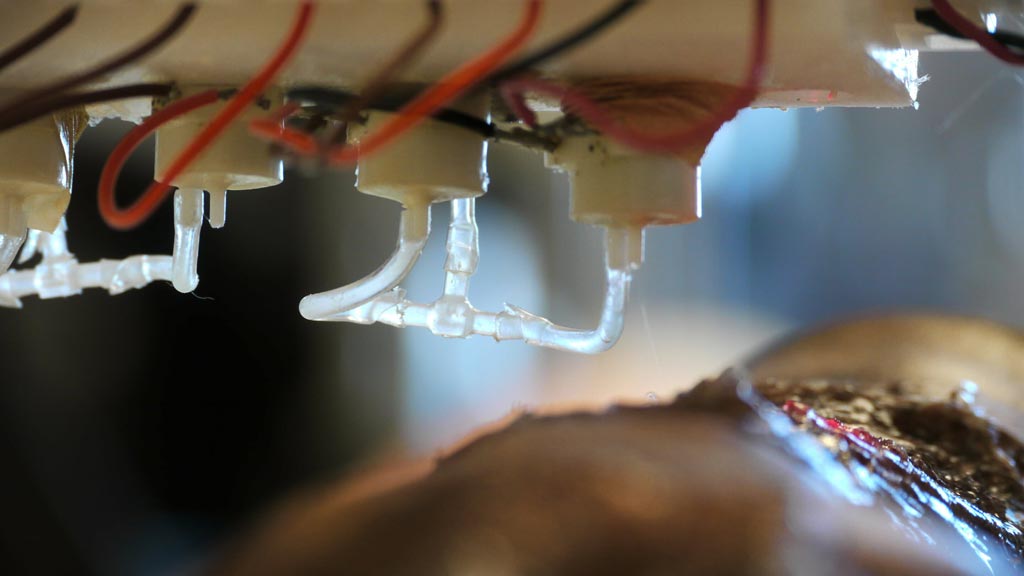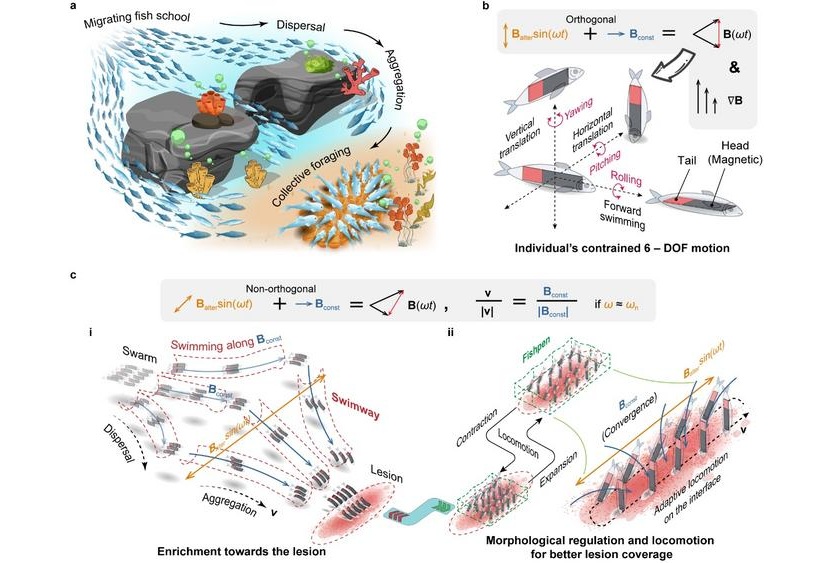Skin Bioprinting System Helps Heal Extensive Wounds
|
By HospiMedica International staff writers Posted on 12 Mar 2019 |

Image: A close up of the nozzle of the skin bioprinter (Photo courtesy of WFIRM).
A mobile skin bioprinter that layers dermal fibroblasts and epidermal keratinocytes directly into a wound can accelerate contraction and re-epithelialization, claims a new study.
Developed at the Wake Forest Institute for Regenerative Medicine (WFIRM; Winston-Salem, NC, USA), the mobile bioprinting system first isolates the major skin cells--dermal fibroblasts and epidermal keratinocytes-- from a small biopsy of uninjured tissue. The cells are then expanded and mixed into a hydrogel and placed into the bioprinter. Using integrated imaging technology the wound is then scanned; the data is used to direct the print heads on which cells to deliver exactly where in the wound, layer by layer.
The process thus replicates and accelerates the formation of normal skin structure and function. The fibroblasts synthesize extracellular matrix (ECM) and collagen, which play a critical role in wound healing, while the keratinocytes reconstruct the epidermis, the outermost layer of the skin. The regenerated tissues show a dermal structure and composition similar to healthy skin, with extensive collagen deposition arranged in large, organized fibers, extensive mature vascular formation, and proliferating keratinocytes. The study was published on February 12, 2019, in Nature Scientific Reports.
“The unique aspect of this technology is the mobility of the system and the ability to provide on-site management of extensive wounds by scanning and measuring them in order to deposit the cells directly where they are needed to create skin,” said lead author Sean Murphy, PhD. “Currently, skin grafts to treat wounds and burns are the ‘gold standard’ technique, but adequate coverage of wounds is often a challenge, particularly when there is limited availability of healthy skin to harvest.”
The early treatment and rapid closure of acute or chronic wounds is essential for normal healing and prevention of hypertrophic scarring; but the use of split thickness autografts is often limited by the availability of a suitable area of healthy donor skin to harvest. Cellular and non-cellular biological skin-equivalents are commonly used as an alternative treatment option for these patients, however these treatments usually involve multiple surgical procedures and are associated with high costs of production and repeated wound treatment.
Related Links:
Wake Forest Institute for Regenerative Medicine
Developed at the Wake Forest Institute for Regenerative Medicine (WFIRM; Winston-Salem, NC, USA), the mobile bioprinting system first isolates the major skin cells--dermal fibroblasts and epidermal keratinocytes-- from a small biopsy of uninjured tissue. The cells are then expanded and mixed into a hydrogel and placed into the bioprinter. Using integrated imaging technology the wound is then scanned; the data is used to direct the print heads on which cells to deliver exactly where in the wound, layer by layer.
The process thus replicates and accelerates the formation of normal skin structure and function. The fibroblasts synthesize extracellular matrix (ECM) and collagen, which play a critical role in wound healing, while the keratinocytes reconstruct the epidermis, the outermost layer of the skin. The regenerated tissues show a dermal structure and composition similar to healthy skin, with extensive collagen deposition arranged in large, organized fibers, extensive mature vascular formation, and proliferating keratinocytes. The study was published on February 12, 2019, in Nature Scientific Reports.
“The unique aspect of this technology is the mobility of the system and the ability to provide on-site management of extensive wounds by scanning and measuring them in order to deposit the cells directly where they are needed to create skin,” said lead author Sean Murphy, PhD. “Currently, skin grafts to treat wounds and burns are the ‘gold standard’ technique, but adequate coverage of wounds is often a challenge, particularly when there is limited availability of healthy skin to harvest.”
The early treatment and rapid closure of acute or chronic wounds is essential for normal healing and prevention of hypertrophic scarring; but the use of split thickness autografts is often limited by the availability of a suitable area of healthy donor skin to harvest. Cellular and non-cellular biological skin-equivalents are commonly used as an alternative treatment option for these patients, however these treatments usually involve multiple surgical procedures and are associated with high costs of production and repeated wound treatment.
Related Links:
Wake Forest Institute for Regenerative Medicine
Latest Surgical Techniques News
- Ablation Reduces Stroke Risk Associated with Atrial Fibrillation
- Optical Tracking Method Identifies Target Areas in Robot-Assisted Neurosurgery
- General Anesthesia Improves Post-Surgery Outcomes for Acute Stroke Patients
- Drug-Coated Balloons Can Replace Stents Even in Larger Coronary Arteries
- Magnetic Kidney Stone Retrieval Device Outperforms Ureteroscopic Laser Lithotripsy
- Absorbable Skull Device Could Replace Traditional Metal Implants Used After Brain Surgery
- Magic Silicone Liquid Powered Robots Perform MIS in Narrow Cavities
- 'Lab-on-a-Scalpel' Provides Real-Time Surgical Insights for POC Diagnostics in OR
- Biodegradable Brain Implant Prevents Glioblastoma Recurrence
- Tiny 3D Printer Reconstructs Tissues During Vocal Cord Surgery
- Minimally Invasive Procedure for Aortic Valve Disease Has Similar Outcomes as Surgery
- Safer Hip Implant Design Prevents Early Femoral Fractures
- New Nanomaterial Improves Laser Lithotripsy for Removing Kidney Stones
- Ultraflexible Neurovascular Microcatheter Delivers Therapies to Tiniest Blood Vessels

- Magnetic Soft Robotic Valve Provides Minimally Invasive Intervention for Acid Reflux
- Wireless Metamaterial Spinal Implants Can Feel, Heal and Communicate
Channels
Critical Care
view channel
'Smart' Shirt Detects Epileptic Seizures in Real Time
Epilepsy affects roughly one in every 100 people worldwide, causing seizures that can range from subtle episodes to severe convulsions and loss of consciousness. These events arise from excessive electrical... Read more
Skin Patch Measures Effectiveness of Flu/COVID Vaccines in 10 Minutes
Early detection of viral infections often depends on blood-based antibody tests that require needles, laboratory processing, and long turnaround times. To overcome these limitations, researchers have developed... Read morePatient Care
view channel
Revolutionary Automatic IV-Line Flushing Device to Enhance Infusion Care
More than 80% of in-hospital patients receive intravenous (IV) therapy. Every dose of IV medicine delivered in a small volume (<250 mL) infusion bag should be followed by subsequent flushing to ensure... Read more
VR Training Tool Combats Contamination of Portable Medical Equipment
Healthcare-associated infections (HAIs) impact one in every 31 patients, cause nearly 100,000 deaths each year, and cost USD 28.4 billion in direct medical expenses. Notably, up to 75% of these infections... Read more
Portable Biosensor Platform to Reduce Hospital-Acquired Infections
Approximately 4 million patients in the European Union acquire healthcare-associated infections (HAIs) or nosocomial infections each year, with around 37,000 deaths directly resulting from these infections,... Read moreFirst-Of-Its-Kind Portable Germicidal Light Technology Disinfects High-Touch Clinical Surfaces in Seconds
Reducing healthcare-acquired infections (HAIs) remains a pressing issue within global healthcare systems. In the United States alone, 1.7 million patients contract HAIs annually, leading to approximately... Read moreHealth IT
view channel
Printable Molecule-Selective Nanoparticles Enable Mass Production of Wearable Biosensors
The future of medicine is likely to focus on the personalization of healthcare—understanding exactly what an individual requires and delivering the appropriate combination of nutrients, metabolites, and... Read moreBusiness
view channel
Philips and Masimo Partner to Advance Patient Monitoring Measurement Technologies
Royal Philips (Amsterdam, Netherlands) and Masimo (Irvine, California, USA) have renewed their multi-year strategic collaboration, combining Philips’ expertise in patient monitoring with Masimo’s noninvasive... Read more
B. Braun Acquires Digital Microsurgery Company True Digital Surgery
The high-end microsurgery market in neurosurgery, spine, and ENT is undergoing a significant transformation. Traditional analog microscopes are giving way to digital exoscopes, which provide improved visualization,... Read more
CMEF 2025 to Promote Holistic and High-Quality Development of Medical and Health Industry
The 92nd China International Medical Equipment Fair (CMEF 2025) Autumn Exhibition is scheduled to be held from September 26 to 29 at the China Import and Export Fair Complex (Canton Fair Complex) in Guangzhou.... Read more














